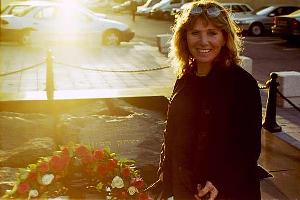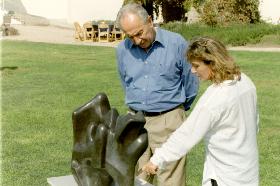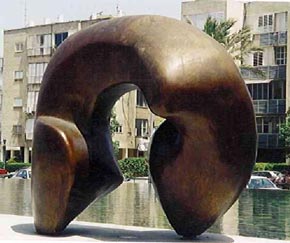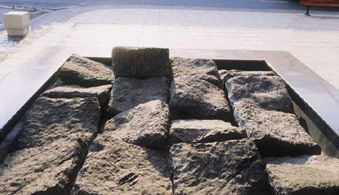|
|
 Yaël Artsi-Moyal (1946) grew up in Morocco and fled to Israel with her family in 1966. She married Ouri Artsi. The two of them settled in the kibbutz at Sdot-Yam near the ancient Roman port, Caesarea. Yaël and Ouri Artsi have three children and two grandchildren. Yaël Artsi-Moyal (1946) grew up in Morocco and fled to Israel with her family in 1966. She married Ouri Artsi. The two of them settled in the kibbutz at Sdot-Yam near the ancient Roman port, Caesarea. Yaël and Ouri Artsi have three children and two grandchildren.
In the early 1970’s Yaël studied under the Israeli painter, Okshi, sculptors: Schterenshus and Michael Shacham. Then in 1973, Yaël and her family moved to Paris where she began her studies at the Académie des Beaux Arts. While in Paris she studied under the sculptor Etienne Martin. In 1976 Yaël received her Masters in Art and Art History. Afterwards Yaël and her family left Paris to resume their life in Sdot-Yam. She has held exhibitions in many countries including Denmark, the United States, France, Italy and Israel. Yaël’s presently busy with the Oerol project 2004 in the Netherlands.
First of all, I want to thank Yaël and Pauline for taking the time to grant me an interview and allowing this great honor of featuring their work. I also want to mention here that much of the background material for
Yaël's feature came from Pauline Brenninkmeijer’s book, Stones with a Human Heart and from Artstream’s site. Without Pauline’s invaluable assistance in providing me with the necessary information as well as photos, I could not possibly have put together this feature, for which I am eternally grateful. Though it would be easy to say that I have been following Yaël’s work for well over a decade, it is not entirely true--Yaël’s work has followed me. My dream is to one day meet Yaël in person but having this opportunity to showcase her work is more than enough to humble my aspirations. I am ecstatic to present Yaël Artsi and Pauline Brenninkmeijer.
¤¤¤¤¤
Mia:I studied sculpting for seven years at a Junior college. One of the first things my instructor told me was that all art would be a reflection of ourselves. He demonstrated this idea when he had the students make a bust of a model out of plaster. My immediate response was to reject his premise: I didn’t believe or want to believe him. But no matter who or what the gender of the model was, every one of our busts uncannily resembled our features. I wanted to break out of the mold and do something more conceptual, abstract, which I thought, would grant me more freedom to express myself. On the contrary it wasn’t until I delved deeper into myself that my sculptures took on a life of their own. This paradox has always troubled me; the idea of polarity or opposites needed to create tension and movement also can be a source of conflict and discord. And yet in reading the book Stones, I was struck by how you embrace the idea of self reflection in tune with earth, nature:
There are three important elements when I start with a sculpture: the Earth, Stone and Me. There is an interaction between the three of us and nothing else exists at that moment. Stone becomes a mirror of the Earth and
me.—Yaël Artsi
Yaël, in much of your work I see evidence of a certain paradox. It’s almost as if your work were symbolic of the yin and the yang. For instance, rough against the polished smooth parts of Woman, In the Beginning, Tolerance; unequal weight distribution in Biblical Lion and Buffalo; geometry pushing against curves in Freedom, Caesarea Gate, Peace Garden. Besides these pieces taking my breath away I wonder if this is where you derive some of your strength and energy from—the need to demonstrate and thus present opposing “movement”.
Nobel Laureate and former Minister of Foreign Affairs, Shimon Peres in your book, describes your work in a different but apt way:
 Sculpture is dancing architecture or singing architecture. The Hebrew language has a famous poem: ”There are people with a heart of stone and there are stones with the heart of people.” Here you can see stones with the heart of the people. Moreover, you can see also stones here that have a twinkle in their eye. It is very difficult to make a stone that speaks such a delicate, specific language as she does....She sees marble she already knows what her sculpture will look like. She does not submit to standards and conventions. She forces marble, stone or iron to
speak her language. Her language is the tongue of humanity, of youths, couples, older people, dialogue and disappointment. It is therefore a comprehensive dictionary, composed of her own words.—Shimon Peres Sculpture is dancing architecture or singing architecture. The Hebrew language has a famous poem: ”There are people with a heart of stone and there are stones with the heart of people.” Here you can see stones with the heart of the people. Moreover, you can see also stones here that have a twinkle in their eye. It is very difficult to make a stone that speaks such a delicate, specific language as she does....She sees marble she already knows what her sculpture will look like. She does not submit to standards and conventions. She forces marble, stone or iron to
speak her language. Her language is the tongue of humanity, of youths, couples, older people, dialogue and disappointment. It is therefore a comprehensive dictionary, composed of her own words.—Shimon Peres
I would like to know in your own words, how do you feel you achieve balance in your work?
Yaël: My sculptures cannot exist without balance. As long as I don’t feel a certain kind of balance, I feel I have failed. But it is of course my personal perception of the notion. To achieve balance in my work is nothing for me, compared to finding a certain kind of balance in my life. Balance is a keyword in life, hence in my work. I always play with this mechanism, as you already pointed out in my sculptures you mentioned above. It is one of my main themes: “Movement embedded in a constant state of balance”. That is what creating is all about. I cannot create when I don’t establish a form of balance. And the good thing is that in my work this happens automatically.

In Pauline’s book I wrote the following: “Balance is also vital in aesthetics. A spectator admiring a sculpture experiences aesthetic pleasure. He is completely unaware of the mechanisms that lure him to this piece of art. In order to achieve aesthetic quality that will attract spectators the artist who created the sculpture knows that a careful planning is required and natural laws are applied, which ensure balance. For example,
in spite of its great mass and the movement within, my sculpture “Equilibrium” keeps its balance on just two points, which barely touch the ground. For me, it reflects the ability to maintain dynamism and progress without compromising aesthetic quality.
Mia: I loved this section where Pauline is describing Old Lady.
I had the same reactions to viewing this sculpture:
It is definitely a sculpture where you can see the results of her study with the famous French sculptor Etienne Martin at the Academie des Beaux Arts in Paris, who always said: “ I want to see in your sculpture that you understand the truth of the body. Each body bears its own truth.” One has the tendency to make things nicer, from an aesthetic point of view. Etienne Martin didn’t allow that. It is like a school, called “ The Beauty of Ugliness”. Rodin already applied this principle.—Pauline Brenninkmeijer
If I understand Martin’s philosophy correctly, he believes that ugliness is truth and therefore beautiful. Yaël, what do you mean
when you
say, “I still do it sometimes, for my own
pleasure?" Sculpt truth, or ugliness? I’m not quite following you
here:
When I sculpt the body I always bear the truth. Now the galleries do not consider this style contemporary anymore, but my clients love it. I still do it sometimes, for my own
pleasure.—Yaël Artsi
Yaël: To sculpt bodies in the style of Rodin, Moore and others, abstract forms based on the human body is what I could do endlessly. I express my own feelings in the sculptures and my clients love it. My bodies are alive and express an inner mood, based on what I see and experience in life. But it is also a stage I have left behind me. And I never make something just for decoration. Every sculpture I create has to contain my soul. Old lady was for me at that moment important, because I dealt with my own feelings about my body becoming older, the body of a middle-aged woman coming into decay. The truth of my own so called “ugliness” and the ugliness of every woman that deals with similar feelings. But the special thing here was that ugliness became a form of beauty, because it was an honest creation. When I sculpt a true feeling it becomes beautiful in a way that it surpasses notions as beauty or ugliness the way we look upon them nowadays in our pressing society. So even if one tries to sculpt “ugliness” it still can contain a certain kind of beauty. While a sculpture of a beautiful woman can become a very ugly piece of art if it doesn’t contain a soul.
Mia: Pauline wrote, "The many abstract sculptures made by sculptress Yaël Artsi-Moyal, mostly of female bodies in various forms, intimate and at the same time transcend the human aspect, pure, sensual, naked, voluminous, with round lines and revealing cavities, are inspired by the richness of her youth, characterized by a powerful matriarch."
Yaël how do you perceive Pauline’s interpretation of your work? I understand that the female body is a very important motif and that it represents birth, fertility, earth, cycles, nature for you. But in a male-dominated culture, being taught by male artists, how did you conceive the female body as something individual and whole but separate from male influence? In other words, what’s remarkable about your work is that it “defies” conventional views about woman’s role of beauty, grace and elegance. Not that your work doesn’t encompass all these ideals, but pregnant (or old) women aren’t generally looked upon as beautiful by either gender in a society where much of the body is hidden in “fashionable” maternity wear that is intended to make the woman look NOT pregnant.
Yaël: I am a person of this time. From childhood on I have always been surrounded by impressive female bodies, often pregnant, in the haman, at home. Later, when I became pregnant myself, I could relate to this feeling of birth very naturally, due to my Moroccan background. The strength and fertility of women has always been a major motive in my work and in my life and that is something that goes beyond a beautiful outside. A man will never experience the feeling of being pregnant or giving birth, which in my opinion makes him less capable to sculpt pregnancy or birth, as a woman
can.
Mia: I think of your art as not only art, but an awareness of how woman can be accepted and perceived in society thus making way for change where evolution can be promoted. In this regard you have gone against all odds to proclaim your right to not only express yourself as an artist, but as a woman.
Having been raised in four different cultures: French, Moroccan, Jewish, Arab, how has it influenced your personal life? I know that you must draw much of your ideas, inspiration from all these varied cultures but I do wonder if some amount of dissatisfaction with trying to find your home base has not in some way made you dissatisfied with your artwork. You are like an expatriate and in some ways that can have a positive influence on your work giving you separate ideas; but in other ways, do you often feel isolated? How do you ground yourself? Are there any questions you have about where you truly belong?
Yaël: I feel like a nomad, never really completely belonging anywhere. Not in Morocco as a Jew, not in the kibbutz, being an artist. But also not in the art world. But this belongs to me. I never wanted to put myself into a frame. I go where I like. I sculpt what I like, without being ruled by certain trends. This of course makes me feel isolated sometimes, but my independence is sacred to me. It is the way I am and became, and it also strengthens me to create.
Mia: Yaël, would you speak a little bit more about your
mother? It seems that you are very fond of her, but how in the world did she have time to devote individual attention to each one of you with ten children?
Yaël: Our education was very matriarchal. You can compare it with a cat that lovingly takes care of her ten kittens. All children received exactly the same treatment, the same mother love. She was a mother full of energy and very creative. Never ill and always at home to welcome us. When I speak with my brothers and sisters about my mother, everyone of us talks about “MY mother”, instead of just “mother”. This is strange because we all talk about the same person. But I think this fact very well describes how she was, to every single one of us, “our mother.”
Mia: One of the things that drew me to sculpting was the idea of subtraction and the fact that the harder the stone the more fragile—another paradox. For instance marble can bruise very easily. I can think of no other art that is created through removal of material so I found this part so true to description:
Stone is my material. I like working. With other materials “ working” never seems to fit
the term, because one can always add some elements. With stone one has to know when
to stop, because once a layer is cut out, it is irreversible. This is the reason why I mostly
like work for itself, but not always its results. I always have the feeling I could have done
better. That same feeling becomes the moving force of my art.—Yaël Artsi
Could we discuss a little about technique? Like what tools do you use?
Air tools, compressor, grinders, sand blasters? Diamond blades? What is your favorite stone? I found a piece of granite weighing 300 pounds and nothing could make a dent in it except a diamond-impregnated blade. But the intense heat created by the blade without water constantly running over the
stone put the stone at great risk of shattering. And in looking at your huge granite pieces, I just can’t even fathom how you work with such large pieces such as the ones for the Oerol project.
Yael: Carving directly in the stone, be it granite, marble or wood, is a method that
has existed already for ages, since prehistory. Imagine how during thousands of years the sculptor helped himself without any mechanical tools, while at the same time we all have witnessed the most beautiful sculptures made ever. The hand is still the most important tool that ever existed. When you have the disposal of any technological solutions, while working for example with hard granite, the most simple way is to use the hammer and chisel, like men have done for ages. But men nowadays don’t posses the time and the patience for this method. In my opinion it is best to combine the two: make use of modern means, but always stay faithful to the traditional way of carving. A sculptor must never forget to experience how his predecessors worked in the old days.
However, the concept of modeling differs completely from sculpturing directly in the stone. Modeling is a way of building, making an esthetic creation. Carving offers me
the occasion to discover the deepest secrets of the soul of a stone and the sculpture in its process of formation. When one models with clay, one adds
or removes material, pieces of clay. The action comes from
outside turning inwards, whereas carving is an action which comes from
the inside to outside.
Mia: Yaël, you once studied painting and decided that it was too passive for you. Was there ever a point where painting was your passion before your discovery of stone? I’m looking at sketches and wondering if you still do paint.
With stone I use my whole body. I could give free rein to my energy, because I kept on working endlessly around the stone. Having 360 profiles at my disposal gave me the opportunity to express myself fully and I liked the cadence of the motion. I need motion. In my sculptures I draw all the profiles as a painter and I give the stone the colours I want. In this way I can create many textures and colours. It is an advantage to make use of the painter in me while I am
sculpting.—Yaël Artsi
Yaël: From the times of my childhood I painted and drew endlessly. Since I became addicted to the stone, I quit painting for myself completely and I do not miss it. Sculpting completely satisfies me.
Mia: Is there any favorite stone, project that has special meaning for you that you’d like to discuss?
Yaël: At the moment I am completely absorbed into my Oerol sculpture I am creating for the Dutch Island of Terschelling. In my mind it already exists. The
symbolism of the granite stones that have been patiently waiting in the sea for exactly hundred years, just for me to transform them in a work of art, is almost supernatural. In this work I can use all my skills and the special circumstances offer me the ideal way of how I like to sculpt. I feel a strong connection with people who live on an island, near the sand and the sea. A community, that I can compare with my way of living in a kibbutz. My whole life I have lived by the sea. I sculpt this Stones Theatre on their island, on location, with their help. They contribute in many ways. Gradually the sculpture will become part of them, like they created it their selves. It takes me a year to do all the sculptures and they follow the whole story from beginning to end, and after that every time when they see it, they will be proud and happy with it. They learn how a sculptor works.
The divers, who collected the stones from the sea, which is a tough job to do, have become my greatest supporters. People who didn’t care so much about art
became immensely involved. The sculptures contain recognizable elements of islander life. It is very hard work for me. The stone is extremely tough. The sculptures have to be huge, in order to be impressive amidst the flat surrounding. I am dependent from what the sea offers me, which makes my work complicated. I have to adjust myself to the sizes, instead of ordering pieces of stone in measurements I need. All this is a great challenge for me, and that’s why I like it all the more. To use my utmost energy because the people will value that. It is a great honor for me to get the chance to do this unique project, that only can arise in this one place, at this moment, and that represents my entire philosophy. More closely sculpting in touch with nature and people is hardly thinkable.
Mia: Lastly, what I would like to discuss is Earthquake which is a memorial dedicated to Yitzhak Rabin. It’s one of your most powerful artistic statements. I don’t think every viewer will get it and I’m not for sure I would have gotten it myself had I not read Pauline’s book:
Each stone expresses my despair, anguish, horror and lack of personal safety. Using an interplay of light and shadow, and an appropriate texture, I created an internal movement in each stone and breathed life in the geometric basalt. Some of the stones reflected my memories of the great man, although I did not always agree with his politics.
I liked the combination of his softness and strength. Other stones evoked my emotions at the time of the murder. I concentrated on him for six consecutive weeks, twenty
four hours a day.—Yaël Artsi
I must tell you though once I read the cited passage, I could literally sense your anger. Especially through your use of geometric, hard squared lines and how the stones are uneven as if in an upheaval. Some things have to be “spelled” out for us. I wouldn’t have thought that this was your most artistic piece, but after viewing it several times, I am struck by the force of this artwork. It is like a blank sheet of paper in which one can project their thoughts. I can’t even describe the feelings I get from just the photo and I imagine if I were able to see it in person how it might affect me differently. I thank you for this memorial to Rabin.

|
Gallery
Oerol Project
Pauline Brenninkmeijer
Contents
|

